The golf resort boom over the last decade has given golfers an ever-expanding number of options for trips. From iconic standouts like Pinehurst and Pebble Beach to new favorites like Streamsong and Bandon Dunes, there has never been a better time in American golf when it comes to publicly available destinations.
Among the best is Sand Valley, which opened in 2017 and now features four 18-hole championship courses and one 17-hole short course, The Sandbox, on the sprawling Wisconsin property. Two of their courses, the namesake Sand Valley and Mammoth Dunes, fall in the top-30 public courses in the country by various outlets, and the newest course, Sedge Valley, will almost assuredly join them in that distinction after opening earlier this year. The Lido, their private course with limited resort play allowed Sunday to Thursday, opened in 2023 and immediately landed at No. 68 on Golf Magazine’s top-100 courses in the world list. Those rankings make Sand Valley one of the nation’s premier golf destinations, but also begs the question: What do those rankings mean for a typical golfer?
I got a chance to find out on a media trip to Sand Valley in early August, playing all five courses over a pretty incredible four-day trip. I started with Sand Valley upon arriving on Saturday afternoon, played Sedge Valley and the Sandbox on Sunday, The Lido on Monday, and wrapped up the trip with Mammoth Dunes on Tuesday before flying out that afternoon. Here, I’ll give my full thoughts on all things Sand Valley, starting with my detailed thoughts on the courses, before getting into everything like caddies, course-planning, food options, non-golf activities, and traveling to and from the resort.
Sand Valley ($295)
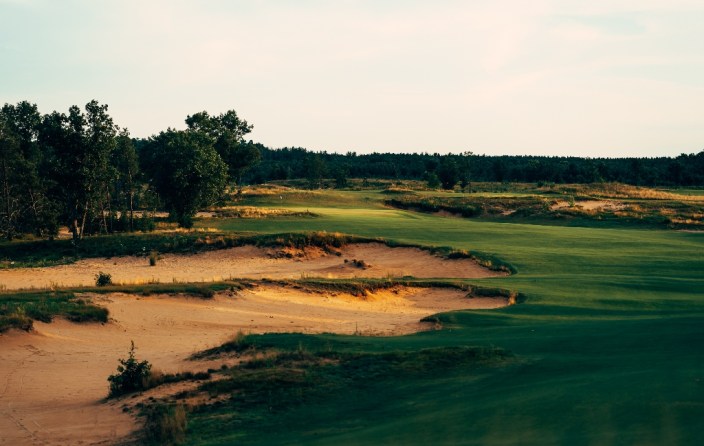
My welcome to the resort was a round at Sand Valley on the day of my arrival, pulling in 20 minutes before my tee time, which meant checking in and heading straight to the tee — no warmup, no putting green. Thankfully, the first hole at Sand Valley is a bit of a handshake from designers Bill Coore and Ben Crenshaw, a 325-yard par 4 that’s certainly drivable for long hitters, but presents options for simply hitting the fat part of the fairway with less than driver and still having wedge into a tiered green with a large false front. It also is an introduction to the test that’s to come, as you’ll be presented with a lot of those same challenges and decisions throughout your round, dialed up to various degrees.
If the first hole is a handshake, the second is a wakeup call. It’s not long on the card (~400 yards from the orange) but plays longer than the yardage and asks difficult questions the entire way. It’s a split fairway, running out at about 250-260, taking driver out of the hand for longer hitters. Laying back gives you a generous landing area to find the short grass, but leaves you with a longer approach hitting up the hill to a green you can’t see from the fairway, with runoffs on all sides. It’s an introduction to the precision required with approaches at Sand Valley, as distance control and finding the proper tier or section of the green are a must.
I played startlingly well on my front nine, going out in an even par 35 despite some windy conditions, but the back nine was a reminder of the thin margins between success and failure at Sand Valley. I caught a couple good breaks on the front and was able to get up and down the few times I got out of position, but I spun the roulette wheel a few too many times on the back and wasn’t so lucky. Compounding my issues was a lack of patience when I put myself in a tough spot. Sand Valley preys on your hubris, often offering you the opportunity for a hero shot to get out of trouble, but with more trouble waiting when you fail to pull it off.
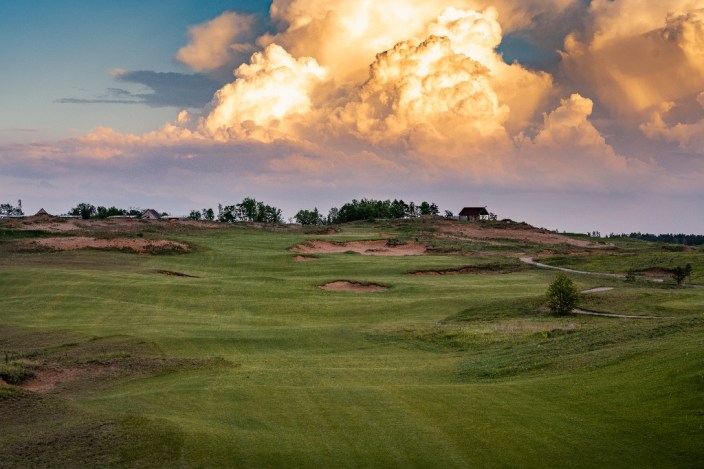
The best example of this for me came on 15, a slight dogleg left par 4 that plays just under 400 yards as long as you go the correct direction off the tee. I hit my worst tee shot of the day, a spinny, high-right disaster that got carried further right by the wind, moving me away from the hole. I drew a decent break, finding sand and not wiry grass, but with the ball above my feet and a blind shot, I tugged my effort at finding the green from 185 away left. This time I didn’t get lucky with the lie, sitting down in some sand with a clump of grass behind the ball and a 50-yard shot. I thinned that over the green, shortsided coming straight down the hill and, again, had a scratchy lie, where the best I could do was leave 35 feet for bogey, resulting in my lone double of the round. It was the full Sand Valley experience, one that could’ve been simply avoided by hitting a 9-iron back into play on my second shot.
A back-nine 42 took a little of the wind out of my sails, but I would’ve gladly taken a 77 if you’d offered it to me on a day where the wind was blowing 15-25 and I arrived to the first tee fresh off a plane and a car ride. I don’t think I’d suggest that as the way most people should plan their trip, but the namesake course on the property delivered on the promise of being one of the nation’s best courses. It was in fantastic shape and for as difficult as it can be, it is an extremely fair test. The fairways are generous, even if they don’t always look like it from the tee, and the landing areas on the greens are a bit bigger than they often look from the fairway.
Sand Valley toes the line beautifully of being challenging while also being playable. It is not a course that exists solely to beat up on you, and gives you plenty of opportunities to put a circle on the card. Everyone in my foursome made a birdie in their round, and if I were to guess, the other three guys I got grouped with were in the ~10 handicap range. However, to score well, you have to be patient and recognize what is actually an opportunity to get after the course, and when to play it smart, especially on a day where the wind is up. That’s a much tougher proposition for most of us, and a double bogey is always lurking just around the corner because it’s extremely easy to go from trouble to worse trouble if you aren’t willing to take your medicine.
Sedge Valley ($295)
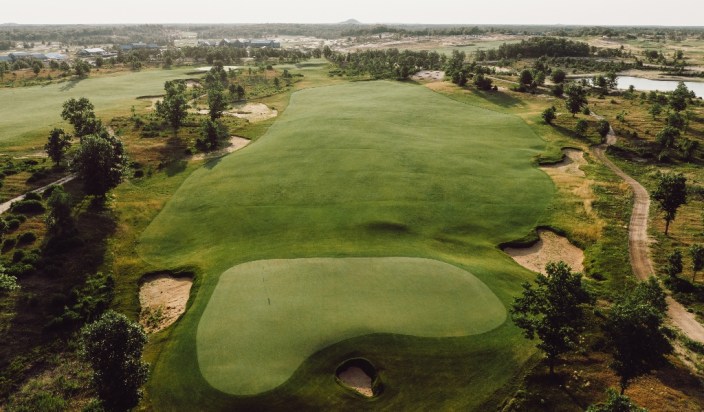
If you talk to just about anyone at the resort — guest or employee — the first course they bring up is Sedge Valley. That’s partially because it’s the newest addition to the Sand Valley property, but it’s also because it’s a truly unique experience that challenges you to think through your round of golf differently than you do at just about any other course.
The Tom Doak design is a par 68, with the back tees clocking in at just 5800 yards, but the caddies and desk staff at check-in urge players to get rid of their traditional thoughts on distance equaling difficulty. Doak’s approach was to simply plot out the best green sites on the property and work from there to build out the course, resulting in a layout with five par 3s, a handful of potentially drivable par 4s, and just one par 5, because that was the best way to route the course to those green sites. That design process results in a fascinating round of golf that demands precision and constantly forces you to do risk-reward calculations. I opted for the Back/Middle combo, with a total yardage of just under 5300 yards, but found it incredibly challenging in spite of — or, probably more accurately, because of — the lack of distance.
When you arrive at most par 4s on a typical course, you simply reach for the driver. At Sedge Valley, that is far from the case, as you can get inside 150 yards throughout much of your round by hitting less than driver. I pulled my 2-iron or 4-iron as often as my driver on the tee box of par 4s, and that was still probably too many drivers, as I found myself pretty regularly fighting with bunkers and thick tall grasses, which I found to be far more difficult to scramble out of than the wispier grass at Sand Valley. Those dangers increase the further down you try to push the ball, as landing areas narrow considerably the closer you get to the hole. A missed fairway will typically lead to bogey (or worse), and even finding the short stuff is only the very beginning of solving the puzzle that is Sedge Valley.
The greens will punish mediocre-to-bad shots, especially on the shorter holes, but it doesn’t feel unfair because you’re constantly going into them with a short iron. That also raises the frustration level when you aren’t dialed in with the wedges, as watching your ball trickle down runoffs, false fronts, or even just find the wrong tier on the green is far more damaging to your fragile ego as a golfer when it happens with wedges rather than a 5-iron. The 77 I shot at Sedge felt worlds apart from a 77 at Sand Valley, as I didn’t get comfortable on the course until I’d hit the middle of the back nine. I walked off most greens kicking myself for a poor decision or poor execution more times than I’d like. But at the same time, I enjoyed being challenged in a different way than usual.
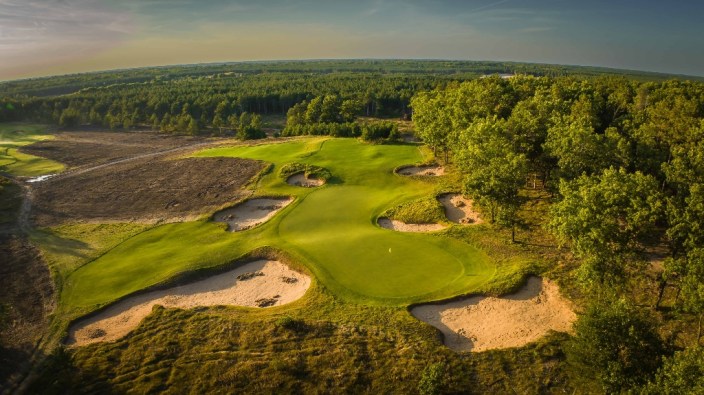
The flip side of that coin is there are also a lot of opportunities to put circles on the cards if you can strike the right balance between being smart and being aggressive. If you can find fairways (which aren’t as hard to hit as I made it look in my round) you’ll have the “scoring clubs” in your hand constantly, and if you’re willing to take on some risk, you can give yourself an eagle look (or chips for seconds) on some of the par 4s. The greens are fast, but still fairly receptive on approach if you can launch the ball high, despite looking like they should be extremely firm. I kept expecting to catch big bounces and runouts that never really came — with the understanding that I played it after a particularly wet summer — and while it took awhile to trust it, once I did I was able to get some approaches in close.
What Sedge Valley does best is challenge your confidence and willingness to make committed swings, and if you catch it on a day where the winds are up a bit, that becomes even more important. You will constantly be given options at Sedge Valley, but options aren’t always the friend of the average golfer. Being forced to hit one “correct” shot sometimes can make it easier to commit fully to it, whereas having multiple avenues at your disposal can let doubt creep in that you’re picking the right option. That’s the greatest strength of Sedge Valley as a course. The lack of distance lulls you into a false sense of security, and instead you’re challenged to craft a plan on every hole and execute each element. For that reason, it’s the course I most want a second crack at, and is also why it’s quickly becoming the favorite course for many on the property.
Mammoth Dunes ($295)

Mammoth Dunes answers the question: What if Sand Valley was nice to you? The fairways and greens are gigantic, and the slopes on the course — from fairway to green — tend to push you towards a good position, rather than running you into trouble. There are still false fronts to contend with and plenty of bunkers and waste areas, but there’s no question that Mammoth Dunes is going to be the course you feel the most comfortable on while at Sand Valley.
The word that comes up the most when you talk with people around the property about playing Mammoth Dunes is “fun.” It’s not a course that puts your game to the ultimate test — go to The Lido or Sand Valley for that — but after you’ve gotten beaten up a bit by the other courses and dealt with the mental grind they present, it’s nice playing a course that wants to help you. The David McLay Kidd design makes it very clear where you want to go with most of your shots at Mammoth, which is a fairly dramatic difference from Sand Valley, Sedge Valley, and The Lido. That helps to puts you at ease and allows you to swing freely, which tends to lead to better scores.
There’s very little stress getting off the tee at Mammoth. The fairways are extremely generous, and while there are bunkers to avoid, there’s plenty of room to dodge them. After a weekend of battling blind tee shots, deceptive sight lines, and just generally stressful tee shots, Mammoth offered a welcome reprieve. I hit 12 of 14 fairways at Mammoth and the two I missed were drives that ran through the fairway and into the rough by just a few feet, as I swung the driver better than I did all weekend. That was largely because I was never thinking about trying to miss trouble (which almost always leads to tightening up) and just let it rip.
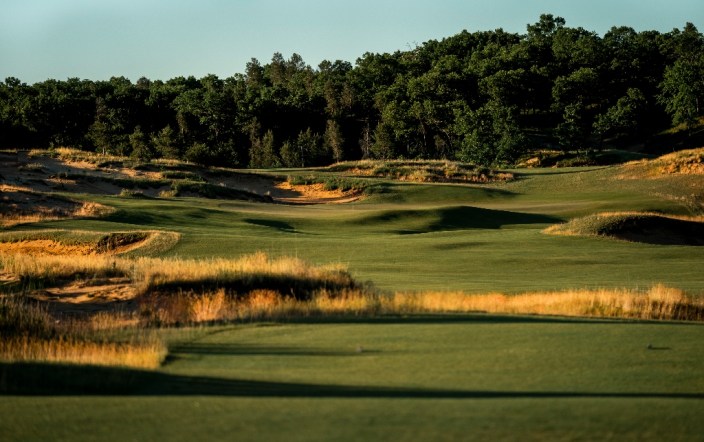
Approaching the green is similarly comfortable, as most of the slopes funnel balls to the greens rather than away from them. That doesn’t mean there aren’t penalties for missing on the wrong side of a hole, as there are still false fronts and runoffs, but the edges of the greens don’t dart away in all directions like you’ll find at the other courses. With larger margins for what constitutes a “good shot” at Mammoth, it’s much easier to get in a rhythm and a groove with your swing. There’s not the same pressure to be precise to the yard the way there is at Sand, Sedge, or The Lido, which, of course, resulted in me having my best ball-striking day of the trip and putting the ball where I wanted it on most holes.
The greens have a decent bit of movement to them but are a touch slower than Sedge and Sand (and a good bit slower than The Lido), and coming off a round at The Lido, I just could not commit to hitting the ball hard enough and kept missing low side. Still, I presented myself with enough opportunities that I made five birdies despite not making a putt over 6 feet all day, en route to a 3-under 70 (which, from the orange, was one stroke better than my handicap said I should’ve shot).
It is extremely fun to play golf like that. There are a few challenges and certainly a big number lurking with a big miss on any hole, but for the most part you’re going to hit fairways, hit greens, and have the chance to go low. The par 5s are all reachable (depending on the wind), and the signature hole is the drivable 14th, where you play your tee shot down a massive hill on the right (or tug a 3-wood and just fly it onto the green like I did).
You couldn’t have every course be like Mammoth, but it’s nice to have a bit of a respite from grinding through rounds at the other courses. A lot of people suggest it as the first course you should play, because it is the easiest, but I really enjoyed closing with it because after playing everywhere else, you truly appreciate (and take advantage of) the opportunities presented.
The Lido ($295)

The Lido’s story is pretty incredible, as Tom Doak’s team took a lost C.B. McDonald design from the early 1900s on Long Island and replicated it across the street from the rest of the resort property, and it immediately landed at No. 68 on the Top 100 courses list. I was interested to see how The Lido matched up to the hype, particularly after hearing it tends to be the most polarizing course on the Sand Valley rotation. After playing it, I fall firmly into the camp that loves it, and talking with caddies it seems that skill level plays a very big role in your enjoyment of the course.
Unlike the other courses, there are far more forced carries — none that were particularly daunting — and almost every approach shot is hitting up at a perched up green with extremely sharp edges and steep drop-offs. That takes away the ground game that can allow players who can’t elevate the ball well to work it around the other courses on property, and if you can’t throw it high in the air, stopping it on the very firm and fast Lido greens is going to be almost impossible. However, as a high ball hitter, I had an absolute blast at The Lido.
I played the from the whites, which clock in at a little over 6500 yards, opting not to beat myself up on Day 3 of my trip from the 7000-yard navy tees (they can tip it out to over 7300 for tournament play, but don’t offer that as an option on normal days). The Lido is the only course on the property that requires you to take a caddie, and that is for very good reason as you hit blind off the majority of the tees, which means you almost never are looking at your landing area and your depth perception gets thrown all out of whack with the way bunkers and greens rise out of the ground. As such, you have to have someone who can point you to the correct target line and let you know where you might need to park the driver to avoid rolling it into a bunker, which you can almost never see from the tee.
The course is immaculate, and even playing early in the morning, it played the firmest and fastest of any of the courses tee to green. That presents both challenges and opportunities, as the length of the course can be mitigated a bit by finding the short grass, as your ball will scoot pretty well along the ground. The fairways are, for the most part, pretty generous, but they’re dotted with pot bunkers, some quite deep, as the design leaned on classics like the Old Course at St. Andrews for inspiration. Getting it running gives you the best chance to get it close and have a shorter club in, which is very helpful for stopping the ball on the firm greens. However, once the ball is on the ground, you’re at the mercy of the many undulations that could guide you into a bunker, where the sand is soft and heavy, and the lips can be steep, making for a difficult combination to get out of.
Something interesting I found at The Lido is that missing big off the tee often gives you a better chance at scrambling for a par than missing small. The waste areas that surround the fairways make for a bit of a dice roll on whether you’ll get a clump of grass blocking your swing, but the grass hasn’t grown up a ton yet and, as such, I found it easier to advance it from the waste area to the green (or at least, around the green) than I did the two times I ended up in a fairway bunker. That’s not to say you should go out there blasting it into the waste areas on purpose — it’s still challenging to get up and down — but it was just an interesting quirk of the layout.
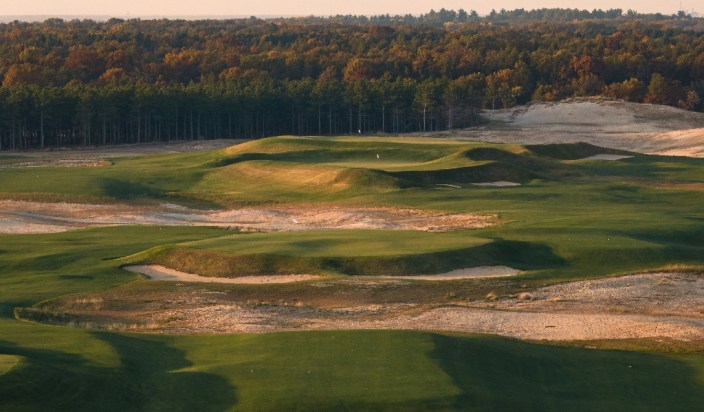
The greens are what stand out most at The Lido. They are massive, and many have defined tiers and huge slopes. Even on the less severe greens, there is almost constant, subtle movement, and you will very rarely stand over a straight putt on this course. As someone who likes being able to see the movement on the greens, I clicked very quickly with them, but I highly recommend giving yourself 15 minutes or so to get acquainted with the practice green before your round, as there is a speed adjustment to make from the courses across the street. Being underneath the hole is vital to scoring, because downhill putts are just so ticklish and you have to respect the fact that “make speed” might put you 10 feet by for a comeback putt.
However, staying below the hole is a lot easier said than done because of how firm they are, especially to front pins. If you want to have a good look at birdie to a front pin, you’re going to have to flirt with landing your approach on the very edge of the green. Because of how most of the greens are elevated with sharp drop-offs, leaving it even a yard short will put you either in a deep bunker or chipping up at least a foot or two and taking away any ability to put check on the ball to greens that bounce and run. As a result, you’re typically going to play to the pin number on a front pin and just accept having a 20-footer back down and try your best to leave a tap-in for par. Of my four birdies on the round, three came with pins that were center or back, allowing for the release on the approach and still leaving an opportunity to make a more aggressive stroke. (The other was an outrageous 40-foot double-breaker on 10 I couldn’t replicate again with 100 tries.)
The Lido is simply a fantastic test of golf, and I see why it landed on the Top 100 list in its first year of being open. I felt much of the mental challenge of the course is on approach, largely because there’s some freedom off of the tee on par 4s and par 5s, since you simply can’t see where the trouble is. My caddie, bless her, would give me a start line and withhold all information about the potential issues that lurked over the horizon until after I hit it, freeing me up to just swing away without lingering thoughts of unseen dangers. However, approach shots required a keen focus to hit your number. I got to play The Lido in about as calm conditions as you’ll get, which contributed to me posting a strong score (75). But when the winds pick up, there is no protection from the elements on the wide open property and it’s a course that plays harder downwind, because it makes stopping the ball an incredible challenge.
The Lido isn’t a course for everyone. I wouldn’t suggest it for high handicappers, because I can see how it would be an absolute nightmare to get around. But that’s also not its intent. It’s supposed to be one of the world’s best courses that poses a unique challenge, and it delivers on that promise in a way that, I think, makes for an phenomenal golfing experience if you’re up for it.
The Sandbox ($75)
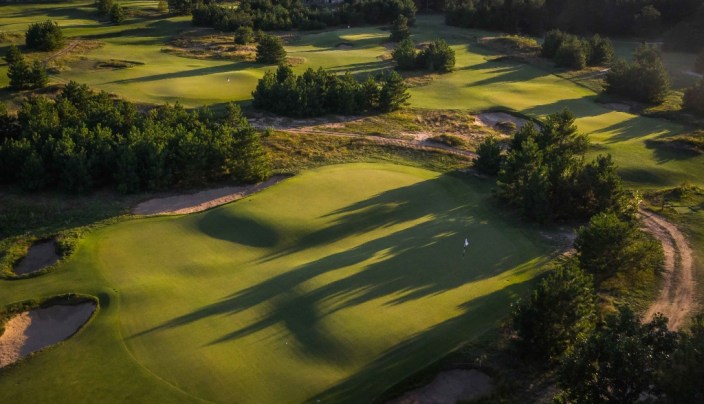
I’ll be honest, I don’t think I got the full Sandbox experience by virtue of being out there solo. It was a great opportunity to work on my wedge game with some fun holes, big slopes, and challenging pin positions, but my favorite part was hearing what was going on around me. I heard a group a few holes over go crazy after someone made a hole-in-one, and a couple others begging for tee shots to drop that just wouldn’t. I watched the group of four older guys in front of me trash talk each other as they played a cash game, discussing how much money had swung on a big putt, made or missed.
That is what The Sandbox is all about. Sure, you get those things happening on the big courses too, but there’s always an internal battle going on with your own score out there. Part of the magic of short courses is it eliminates that element of stress — you’re not putting your score on The Sandbox into the GHIN — and invites you to have a bit more fun. I didn’t quite get that playing alone, as I spent my time trying to dial in my feels from 50-100 yards, but for groups looking to tack on a little more fun to the trip, it’s a great spot to unwind while still playing golf.
What Order Should You Play The Courses?
When I make a trek back to Sand Valley with some friends, I think I’ll look to go in this order: Sedge Valley, Sand Valley, The Lido, and Mammoth Dunes. I understand the suggestion to start with Mammoth as a way to ease into the trip, but I really loved ending on a high note and I don’t think it looks quite as inviting until you’ve played the rest. Sedge would allow you to get settled in a different way, playing a course that you don’t need to bang driver off every tee. From there, you get the two biggest tests with Sand Valley and The Lido, where by the third round of the trip you should be pretty dialed on distances. Then, you go over to Mammoth to end things, where the fairways will look a mile wide and you can really try to get after it and go low.
I will note that with how long it takes to get to the resort from the airport (~2.5 hours from Milwaukee), you don’t really want to be cutting it too close with your timing on arrival, or if you’re trying to rush before you have to leave. I did that first thing, and while it worked out, it was a bit stressful and I needed everything to go exactly right with my flight landing a little early, my clubs being the first thing off the plane, and the rental care line being just three people to make it happen. For that reason, an early evening Sandbox visit the day you get in is probably the smart play unless you can get a flight that lands in the mid-morning.
If I were booking a Saturday-Tuesday trip, landing midday Saturday and leaving in the evening on Tuesday, this is how I’d try to structure the trip.
Saturday: The Sandbox
Sunday: Sedge Valley, Sand Valley
Monday: The Lido
Tuesday: Mammoth Dunes
That gives you a chance to loosen up on The Sandbox upon arrival and puts your day of 36 holes (which, every course at Sand Valley is walking only) on the first day when the legs are still fresh. If you’re skipping The Lido, you could look to tack a second round on at one of the other courses in that spot. For me, the course I’d look to play twice would be Sedge, just because there’s so many different ways to play it and walking off the first time you’ll have a lot of thoughts on things you’d like to do differently.
Caddies
The caddie fee is $100 per bag (paid cash to the caddie after the round, plus gratuity), and I think it is well worth it, especially on your first visit to each of the big courses. Mammoth is perhaps the one you can get away without, as it’s a bit more straightforward and less punitive, but you really need someone who can tell you where to go and where to avoid at Sand and Sedge. Beyond getting yardages and start lines, I always play better when I talk through each shot, and I force myself to go through that process with a caddie, even if their only input is to nod and say “I like that.” You also will stick with the same caddie throughout your trip (if possible), which allows them to get to know you and how you like to play, which leads to their suggestions getting more tailored to your game.
Non-Golf Activities
The main attraction at Sand Valley is unquestionably the golf, and while you could pack in 36 holes a day if you wanted, you will probably want to give yourself a little bit of a break. There are plenty of other outdoor activities at Sand Valley, like fishing, hiking, bike riding, and more, as you can explore the property with trails that meander all around the courses. You also can play grass court tennis, as they have the largest grass tennis facility in the United States over by Sedge Valley. The courts are immaculate and while it takes a bit of getting used to the lower bounces, it is a cool experience, and a different game from hard court tennis most of us are accustomed to playing.
Dining
There are three main restaurants at Sand Valley, along with unique food options on each of the courses where most things cost $1. The favorite is Craig’s Porch at Sand Valley, where the $1 tacos are a delight and worth the quick pitstop at the turn. Over by the Sandbox is Bill’s BBQ, which is also open to the public from 11 a.m. to sundown, which is a good place to get a quick bite not far from the clubhouse.
As for the main restaurants, The Gallery is the newest option over by Sedge Valley, offering Italian fare. I highly recommend the pizza — the artichoke pizza was great and the pepperoni that walked by my table looked fantastic — and multiple people told me unsolicited the chicken parm is excellent. Aldo’s Farm & Table at the clubhouse offers high-end American fare, headlined by their steaks, while next door at Mammoth Bar, you can get a bit more casual dining and sit out on the patio overlooking the 18th at Mammoth Dunes — the smashburger at Mammoth Bar is sensational.
Transportation
You will need to rent a car to get out to Sand Valley, as it is a little over 2.5 hours from Milwaukee and just over 3 hours from Minneapolis. But once you’re on the property, the shuttle buses run constantly and will take you anywhere you need to go in about five minutes.
It didn’t take long to understand why Sand Valley is high on the lists of must-play golf destinations. Every round presents something different, from challenging your game at the highest level to asking you to think about golf differently than you do just about anywhere else. Course rankings don’t always translate to an enjoyable round of golf, but I thought the courses at Sand Valley strike a really good balance between challenging and fun. Some skew more to one end of that spectrum or the other, but in total, you will leave feeling like you got a complete golf experience that was unique to anywhere else you’ll go.
Uproxx was invited on a hosted trip to Sand Valley for reporting on this piece. Sand Valley did not review or approve this story. You can find out more about our policy on press trips/hostings here.







